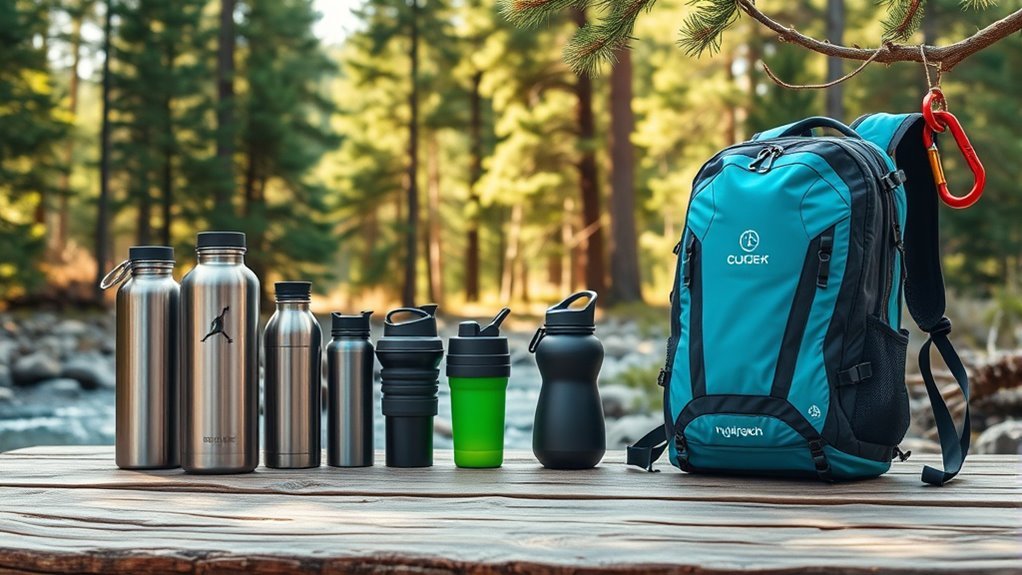When planning a long hike, you know that staying hydrated is essential for maintaining your energy and preventing dehydration. However, with numerous hydration options available, it can be challenging to determine what’s best for you. Do you go for a hydration reservoir, a trusty Nalgene bottle, or perhaps something ultralight? And what about electrolyte drinks or herbal teas? There’s more than meets the eye when it comes to choosing the right hydration strategy.
Key Takeaways
- Use a 3-liter hydration reservoir for easy access to water during long hikes.
- Opt for electrolyte-infused beverages to replenish essential nutrients and enhance fluid absorption.
- Monitor thirst signals and urinary color to accurately gauge hydration levels.
- Include sodium- and potassium-rich snacks, such as pretzels and bananas, to help balance electrolytes.
- Avoid overhydration by tracking your water intake and aiming for approximately 10 fl. oz. every 20 minutes.
Importance of Staying Hydrated on Long Hikes
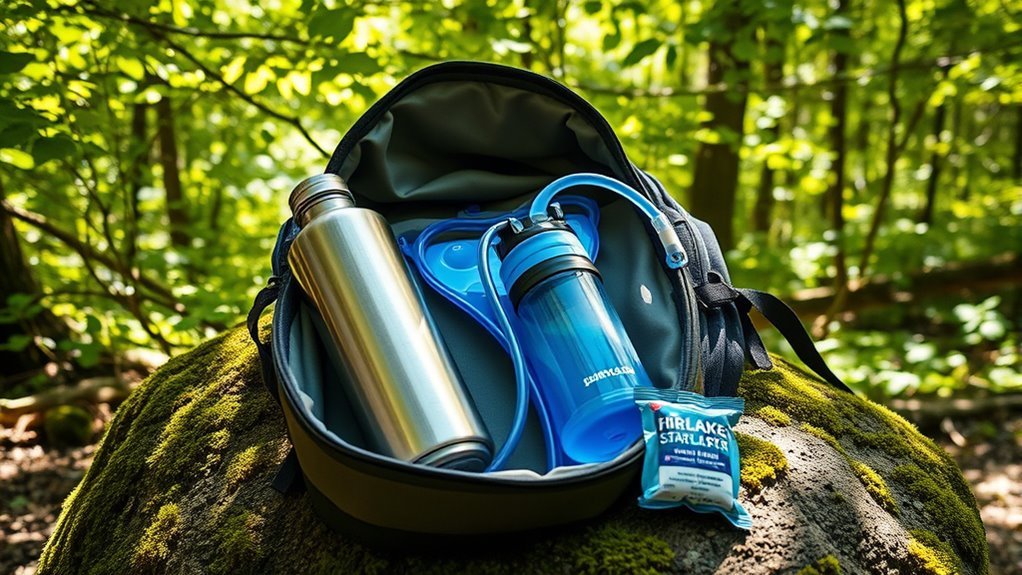
When you’re out on a long hike, staying hydrated is fundamental for your health and performance. Your body, which is composed of roughly 60% water, relies on proper hydration to regulate its temperature and aid digestion.
During hiking, especially in hot weather, you lose more water through sweat, increasing your risk of dehydration. This can lead to a dry mouth, decreased energy, and potentially unsafe hiking conditions.
To combat this, aim for a daily water intake of 3-4 liters, sipping small amounts frequently. This approach helps maintain energy and prevents fatigue.
Determining Your Water Needs
When planning your hike, consider both the activity level and the climate to determine your water needs.
Calculate how much water you’ll need by evaluating your hydration rate, which can range from 0.5 to 1 liter per hour, depending on the conditions.
Monitor thirst signals, such as a dry mouth and low energy, to adjust your intake as needed.
Activity and Climate Factors
Understanding how much water you need on a long hike involves considering several factors, including the type and intensity of your activity, as well as the climate conditions you’ll encounter.
To stay properly hydrated, you’ll need to adjust your water intake based on these elements:
- Activity Intensity: Moderate activities typically require about 0.5 liters of water per hour. Strenuous hikes might demand up to 1 liter or more, especially in hot weather.
- Climate Conditions: Hot weather increases sweating, so it’s essential to hydrate properly to prevent dehydration.
- Altitude: Higher altitudes can suppress thirst, making it essential to drink regularly even if you don’t feel thirsty.
- Personal Factors: Consider your age, sweat rate, and body type, as these factors can influence the amount of water you need.
Hydration Rate Calculation
Calculating your hydration needs for a long hike is essential to guarantee you stay energized and healthy. A good rule of thumb is to drink approximately 0.5 liters of water per hour during moderate activities and up to 1 liter per hour in high temperatures to prevent dehydration.
When day hiking, you’ll want to carry water efficiently. Consider using hydration packs or a hydration reservoir; they make it easier to sip regularly.
Remember, factors such as age, body type, and sweat rate can affect your personal water needs. Fine-tune your intake based on these variables.
After your hike, rehydrate by drinking 16-24 fl. oz. of water for every pound lost. Keeping these guidelines in mind helps assure a safe and enjoyable hiking experience.
Monitoring Thirst Signals
How do you truly know if you’re drinking enough water on a hike? Monitoring thirst is essential. Thirst typically signals your body’s hydration needs, but it can be unreliable at higher altitudes, which can lead to dehydration.
To guarantee you’re adequately hydrated, consider these tips:
- Urinary Color: Check the urine color; a pale yellow color indicates proper hydration, while a dark yellow color indicates dehydration.
- Physical Signs: Be alert to signs of dry mouth or fatigue, as these can indicate early dehydration. Severe signs include cramps and headaches.
- Rehydration Rule: Drink 16-24 fl. oz. of water for every pound lost during your hike.
- Drinking Habits: Take small sips often instead of chugging to maintain hydration without overwhelming yourself.
These strategies will help you effectively manage your water intake on long hikes.
Choosing the Right Water Container
When you’re planning a long hike, selecting the right water container is essential for staying hydrated without hassle.
A 3-liter hydration reservoir is ideal for a backpacking trip, allowing you to sip easily from a hydration pack without stopping. For those who prefer a classic water bottle, the 1-liter Tritan Nalgene is a durable choice.
If you’re counting ounces, ultralight bottles, such as repurposed plastic containers, weigh under 2 ounces and help keep your pack light. Insulated bottles are effective in cold weather, preventing freezing.
Regardless of your choice, ensure your hydration system or bottle is easily accessible—store them in mesh pockets or attach them to your shoulder straps. This way, you can stay hydrated throughout your adventure.
Benefits of Electrolyte-Infused Beverages
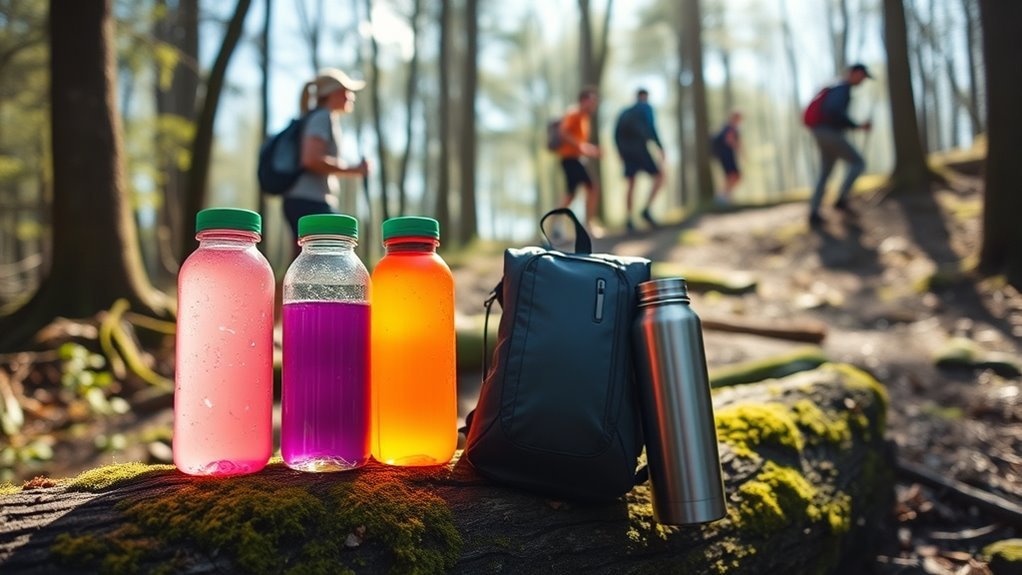
When you’re tackling long hikes, electrolyte-infused beverages can be your best friend.
They enhance your hydration efficiency by replenishing essential nutrients, such as sodium and potassium, that are lost through sweating, which helps maintain muscle function and fluid balance.
Plus, these drinks can boost your physical performance with added carbohydrates, providing a steady energy source to keep you going.
Enhanced Hydration Efficiency
Although plain water is the go-to choice for many hikers, incorporating electrolyte-infused beverages into your hydration routine can greatly enhance your hydration efficiency.
When you’re tackling long trails, these electrolyte drinks offer several advantages:
- Improved Rehydration: They provide essential sodium and potassium, aiding rapid rehydration during long hikes.
- Enhanced Fluid Absorption: Electrolyte drinks can boost fluid absorption by up to 20% compared to plain water, maximizing hydration on the trail.
- Sustained Energy Levels: By maintaining the ideal sodium-to-potassium ratio, you support ideal muscle function, keeping energy levels stable.
- Increased Endurance: Consuming these beverages can significantly enhance endurance and recovery, thereby reducing the risk of dehydration-related issues.
Incorporating these drinks guarantees you stay hydrated, energized, and ready for the next challenge.
Replenishing Lost Electrolytes
Exploring the benefits of electrolyte-infused beverages reveals their significance in replenishing lost electrolytes during long hikes. As you traverse challenging trails, these drinks, such as sports drinks and hydration mixes, help replenish lost sodium and potassium, which are essential for muscle function and cramp prevention. They enhance water absorption and nutrient uptake, which is vital for hydration during strenuous activities. Consuming 16-24 fl. oz. of fluid for each pound lost in sweat ensures effective rehydration. Options like Liquid I.V. and Nuun provide essential electrolytes without excessive sugar, thereby preventing hyponatremia and its associated symptoms, such as fatigue and nausea.
| Benefit | Solution | Recommended Use |
|---|---|---|
| Replenish Lost Sodium | Sports Drinks | 16-24 fl. oz. per pound |
| Maintain Muscle Function | Electrolyte Beverages | During long hikes |
| Prevent Hyponatremia | Low-Sugar Options | Regular intake |
Boosting Physical Performance
Even the most seasoned hikers know that maintaining peak physical performance on long trails requires more than just grit and determination.
Electrolyte-infused beverages are your secret weapon to boost physical performance by enhancing hydration efficiency. Here’s how they help:
- Fluid Balance: They maintain fluid balance, which is essential for peak performance, especially in hot conditions where sweat loss can exceed one liter per hour.
- Water Absorption Rates: With the addition of sodium, these beverages increase water absorption rates by 30% compared to plain water.
- Muscle Function: Sodium and potassium play crucial roles in supporting nerve function and muscle contraction, thereby preventing cramps and maintaining endurance.
- Prevent Hyponatremia: Regular intake helps prevent hyponatremia, a condition that can cause nausea and confusion during long hikes.
Choose wisely and stay hydrated.
Exploring Herbal Tea Options for Hydration
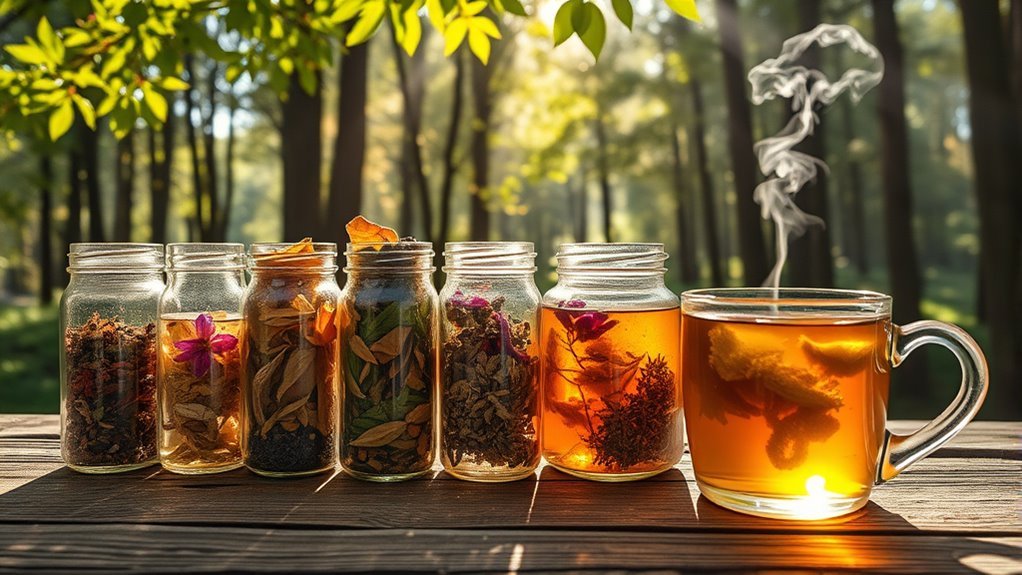
When you’re planning a long hike, don’t overlook herbal teas as a valuable hydration option.
They’re caffeine-free, enhancing fluid intake without the risk of dehydration associated with caffeinated drinks. Consider herbal teas like peppermint, chamomile, and hibiscus for their soothing and antioxidant properties.
They’re versatile for any weather, whether warm or cold. For convenient on-the-go hydration, pack lightweight tea bags or loose-leaf options in a portable infuser. This guarantees easy access to your preferred hydration method.
Herbal teas can also be combined with electrolyte-rich ingredients, such as coconut water, to enhance hydration and nutrient replenishment during strenuous activities.
Embracing these hydration options helps maintain your fluid levels and supports your body’s needs while you tackle the trails.
Tips for Balancing Electrolytes With Snacks
While starting on long hikes, it’s essential to maintain your body’s electrolyte balance to guarantee peak performance and prevent fatigue. Here are some tips:
- Choose snacks wisely: Opt for snacks high in sodium and potassium, like pretzels, salted nuts, or electrolyte-infused energy bars. These help replace electrolytes lost through sweat.
- Add about 1/4 to 1/2 teaspoon of salt per liter to your water bottles to maintain sodium levels.
- Incorporate potassium-rich foods: Foods such as bananas, oranges, and coconut water can help prevent muscle cramps and support proper muscle function.
- Use sports drinks: Complement your snack intake with sports drinks or hydration mixes containing electrolytes to promote balanced hydration.
Listen to your body; fatigue or cramps might mean it’s time for more electrolytes.
Strategies for Preventing Dehydration
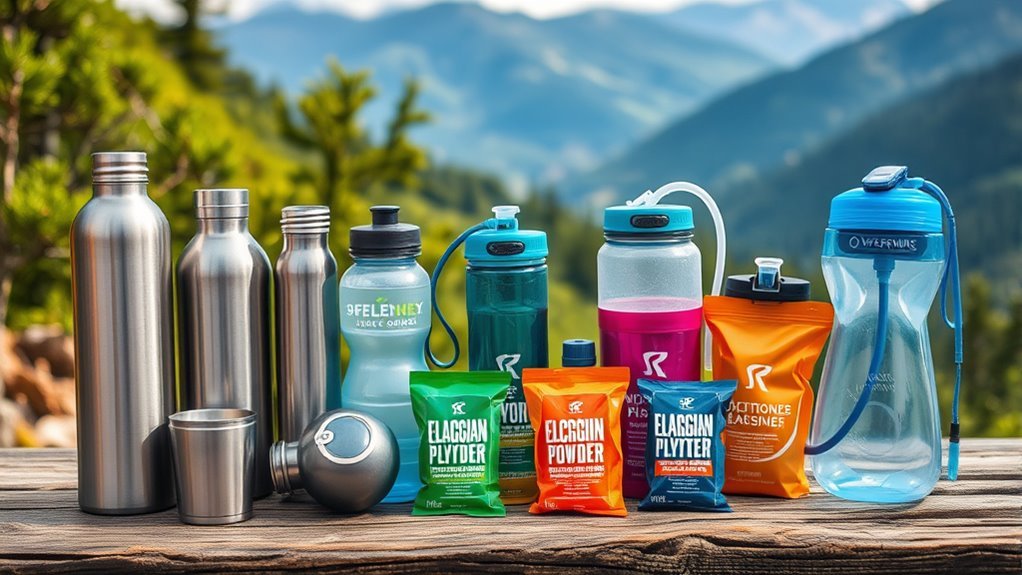
As you begin a long hike, staying hydrated is essential for maintaining energy and avoiding fatigue.
Use a hydration bladder for easy access to water, especially during a day hike involving moderate activity in moderate temperatures. This allows you to sip consistently, aiming for 0.5 to 1 liter per hour, depending on the conditions.
Keep an eye on water sources along the trail to refill and guarantee you have enough to regulate body temperature effectively. Be alert for early signs of dehydration, such as a dry mouth or decreased energy. When you notice these signs, drink water immediately.
Don’t forget to include electrolyte-rich snacks to replenish lost salts, which helps maintain balance during prolonged sweating. Adjust your intake for higher altitudes or hotter weather.
Avoiding Overhydration on the Trail
How can you guarantee you’re not overhydrating on the trail? Start by understanding that overhydration, or hyponatremia, can be as dangerous as dehydration. Here’s how to avoid it:
- Monitor Intake: Drink approximately 10 fl oz of water every 20 minutes during moderate activity. This helps prevent excessive water intake.
- Use Hydration Reservoirs Wisely: They’re convenient, but don’t mindlessly sip from them. Track your water consumption to ascertain balance.
- Consider Water Treatment: Confirm that your drinking water is safe, but avoid overfilling water containers beyond your needs, especially in cooler conditions.
- Check for Symptoms: Recognize signs like bloating and confusion. They might signal overhydration rather than dehydration.
Evaluating Hydration Mixes and Powders

Balancing your hydration strategy on the trail doesn’t stop at avoiding overhydration. Choosing hydration mixes that replenish lost electrolytes is vital for long hikes.
Products like Liquid I.V. offer a potent mix of 560mg of sodium and 370mg of potassium, which are essential for rehydration. However, its 11g sugar content aids nutrient absorption but mightn’t suit everyone.
If you’re looking for a low-sugar option, Nuun Sport Tablets deliver 300mg of sodium with just 1g of sugar, providing a fizzy, invigorating drink.
For cost-effective hydration, DripDrop ORS offers a WHO-based formula with 330mg of sodium and 180mg of potassium, available for $1.12 per serving.
With various flavors available, you can select a hydration mix that matches your taste and hydration needs.
Conclusion
As you embark on long hikes, remember that staying hydrated is crucial to your success. Choose a water container that fits your style, whether it’s a 3-liter reservoir or a lightweight bottle. Don’t forget to incorporate electrolyte-infused drinks and herbal teas to enhance hydration. Balance your electrolytes with strategic snacks and be mindful of water sources on the trail. Finally, avoid the pitfalls of dehydration and overhydration by listening to your body’s needs and adjusting your intake accordingly. Happy hiking!
FAQs
1. How to Stay Hydrated on a Long Hike?
Stay hydrated by sipping 0.5 to 1 liter of water per hour, depending on the heat and your level of activity. Pre-hydrate in advance, use a hydration pack for easy access, and incorporate electrolytes to replenish essential nutrients.
2. What Is the Best Electrolyte Replacement for Hiking?
You should consider Liquid I.V. for its higher electrolyte content, especially on demanding hikes. If you prefer fewer calories, opt for Nuun tablets. Remember, balancing your electrolytes with snacks like pretzels guarantees ideal hydration.
3. How Much Water Should You Drink on a 20-Mile Hike?
You should drink about 0.5 to 1 liter of water per hour on a 20-mile hike. Adjust based on conditions and your body’s needs. Listen to your body, and don’t wait until you’re thirsty to hydrate.
4. How Much Water for a 10-Mile Hike?
You should drink 2 to 3 liters of water for a 10-mile hike. Aim for 0.5 to 1 liter every 5 miles. Remember, taking small sips frequently helps maintain hydration better than large gulps.
Related Article
Trekking Poles 101 Dont Hit the Trail Without Them
Ski and Snowboard Resorts North Carolina
